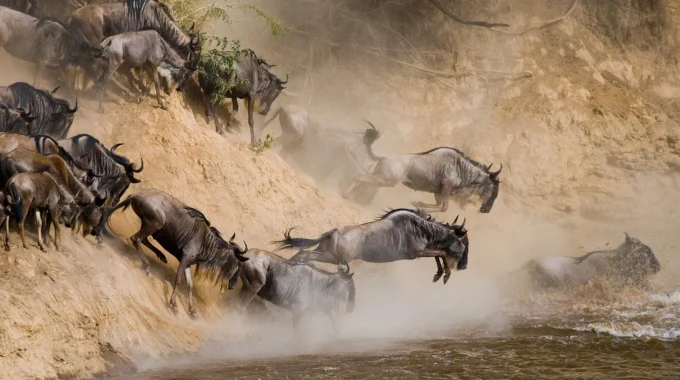A Kenya safari cost can vary significantly based on several factors, such as the season,…
When to see the Great Migration in Tanzania?
When to see the Great Migration in Tanzania? –
The Great Migration in Tanzania, which involves the movement of over 1.5 million wildebeest, zebras, and gazelles, is one of the most spectacular wildlife events in the world. The migration follows a circular route in search of fresh grazing and water, primarily between Serengeti National Park in Tanzania and the Maasai Mara National Reserve in Kenya. The timing of the Great Migration is influenced by the rainfall patterns and the availability of food and water. Here’s a detailed breakdown of when and where to see different parts of the migration:

1. Calving Season (Late January to February)
- Where to see: Southern Serengeti (Ngorongoro Conservation Area and Ndutu area)
- What to see:
- The calving season is one of the most dramatic and beautiful phases of the migration. During this period, thousands of wildebeest give birth, and there are usually around 500,000 births in a span of just a few weeks.
- The abundance of newborns also attracts predators, including lions, cheetahs, and hyenas, which creates intense wildlife action.
- This is a great time to see large groups of wildebeest and other herbivores in the lush, green plains of the southern Serengeti.
- Best time to visit: Late January to February is when the calving happens, and you can see newborn wildebeests taking their first steps in the grassy plains.
2. Migration North (March to May)
- Where to see: Serengeti (central to western) and beyond, heading towards the Maasai Mara.
- What to see:
- After the calving season, the herds gradually start moving north toward the western Serengeti and then cross the Grumeti River, where they face the peril of crocodile-infested waters.
- The herds travel through the western and northern parts of the Serengeti, towards the Mara River (around May).
- Best time to visit: March to May is when the herds are migrating towards the north. This is also the rainy season, which can mean fewer tourists and a lush landscape but also occasional muddy conditions.
3. River Crossings (July to September)
- Where to see: Northern Serengeti, Maasai Mara (Mara River)
- What to see:
- One of the most iconic parts of the migration is the dramatic river crossings, particularly at the Mara River, where herds must brave fast-moving waters filled with crocodiles.
- This is when you’ll see the large groups of wildebeest and other animals crossing into Kenya’s Maasai Mara from the Serengeti. The crossings are often chaotic and dangerous, making it an unforgettable sight.
- It’s also the time when predators like crocodiles and lions take advantage of the vulnerable animals.
- Best time to visit: July to September is the peak time for river crossings. This is the high season for tourism as it’s the most dramatic part of the migration. However, this also means it’s more crowded, so booking early is essential.
4. The Migration in the Maasai Mara (July to October)
- Where to see: Maasai Mara National Reserve (Kenya)
- What to see:
- After crossing the Mara River, the wildebeest and zebras will spend several months in the Maasai Mara, grazing in the reserve’s grasslands.
- During this period, the herds can be seen in the Mara’s open plains, often followed by predators like lions and cheetahs.
- It’s a good time to see the herds in their full migratory numbers.
- Best time to visit: July to October for a chance to see the migration in Kenya. The Maasai Mara is less accessible in the rainy months, so the best time is during the dry season when animals gather in larger numbers.
5. Return South (October to December)
- Where to see: Maasai Mara, then back to Serengeti
- What to see:
- After spending several months in the Mara, the wildebeest and zebras begin their journey south, following the rains and searching for fresh grazing lands. They cross the Mara River again and head back into Tanzania’s Serengeti.
- The herds will pass through the central Serengeti and head back to the southern plains, completing their circular migration route.
- Best time to visit: October to December is the time when the migration is heading back south. While the herds may not be as concentrated as during the river crossings, it’s a good time to see them in central Serengeti.
Summary of Best Times to See the Migration:
- Late January to February: Calving season in the southern Serengeti (Ndutu).
- March to May: Migration heads north through western Serengeti, with river crossings starting to occur.
- July to September: The iconic Mara River crossings, when wildebeest and zebras cross into the Maasai Mara.
- October to December: Herds head back south to the Serengeti.
Other Considerations:
- Weather: The migration is highly influenced by the rains. The pattern of the migration can vary from year to year depending on the rainfall and the availability of fresh grass and water.
- Crowds and Costs: The peak season for tourists is between July and September, especially around the river crossings. Expect higher prices and more tourists during this time.
- Safari Types: There are multiple ways to experience the migration, including game drives, hot air balloon safaris, walking safaris, and even mobile camping for a more immersive experience.
In summary, the best time to see the Great Migration in Tanzania depends on the phase you want to witness. For dramatic river crossings, visit from July to September, and for calving and newborns, go in late January to February. Each season offers a unique and thrilling part of this epic natural event.



